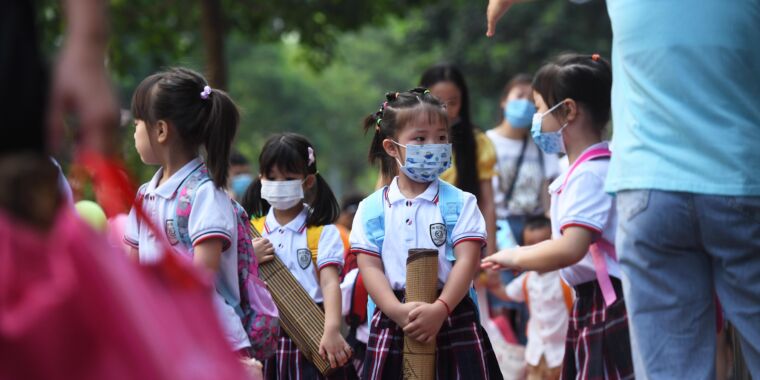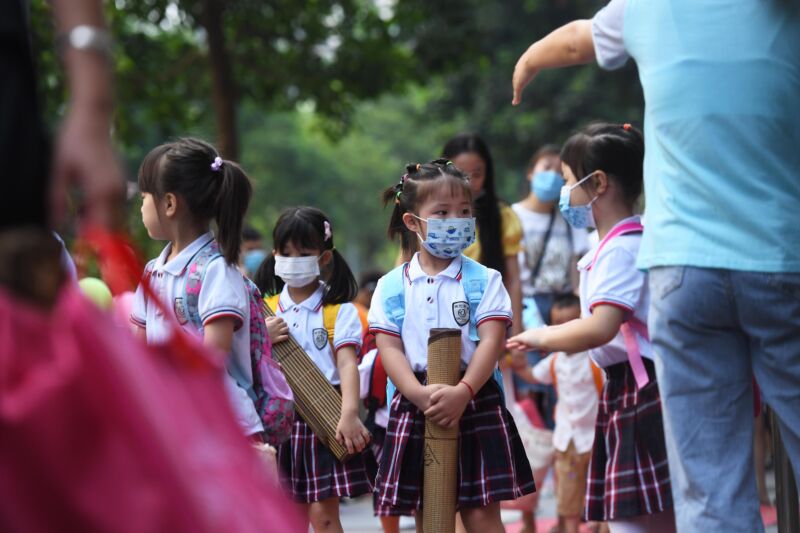
Get your tissues–.
In coronavirus’ wake, garden-variety bacteria might come roaring back.

Enlarge/ Kids go back to kindergarten following COVID-19 lockdown.
In our soft COVID bubbles, our immune systems may be getting soft.
Physical distancing, lockdowns, masking, and perky sanitizing all imply we are entering contact with less garden-variety germs than normal. This year’s flu season was generally cancelled.
While that might seem like a welcome reprieve from seasonal disorders and pesky sniffles, professionals fear that our immune systems might be losing their defensive edge in the lull. And with the normal microscopic suspects waiting for our return to some sense of normalcy, it could imply that nasty bursts of colds and flu-like illnesses remain in our post-COVID futures– ones that might not be avoidable even if we continue with a few of our COVID safety measures.
That seems to be what played out in Hong Kong. In an analysis published in the journal Emerging Transmittable Illness, scientists noted a significant burst of upper respiratory infections there soon after children returned to schools and day cares in October2020 The outbreaks emerged even though instructors and trainees were still following strict COVID preventative measures.
” Personnel and trainees wore face masks at all times; lunch hours were cancelled, desks were spaced out, and group activities were limited,” the researchers noted.
Still, by the end of November, the scientists tallied 482 outbreaks of upper respiratory infections in schools.
When researchers took a look at laboratory testing on the particular bacteria behind the snotty surge, they found no infections from the unique coronavirus, SARS-CoV-2, and no infections with influenza viruses. Instead, the screening pointed to rhinoviruses and enteroviruses– offenders of the common cold and other similarly moderate infections.
Roaring back
The researchers hypothesize that the burst of annoying bugs was substantiated of immune actions in the kids subsiding while in-person knowing was mostly closed down between January and late September. A cross-sectional study had earlier recommended that 75 percent of school children did not have contact with people outside their families while they ran out school.
As cases of colds and flu-like diseases plunged throughout that time, “population vulnerability to rhinoviruses and other breathing infections, including influenza viruses, may have been increasing gradually since individuals were likely less exposed to the viruses when extreme social distancing steps, including school terminations, were executed in action to the COVID-19 pandemic,” the researchers recommend. “This would have increased transmission capacity when schools resumed.”
They keep in mind that a comparable rise in typical colds was seen in adults in England a couple of weeks after schools resumed there in September.
” Nonpharmaceutical interventions might vary”
As for how the infections still managed to spread with the COVID-19 precautions in place in the reopened schools, the researchers have another hypothesis: essentially, COVID preventative measures don’t work well versus common cold germs.
Typically, different breathing viruses use the very same set of transmission modes (surfaces, respiratory droplets, etc.), however “just how much each mode contributes to transmission of a specific infection remains uncertain; therefore, the effectiveness of specific nonpharmaceutical interventions might differ between viruses,” the scientists write. In other words, masks and disinfection may be extremely efficient versus flu viruses and SARS-CoV-2, however they may not be as efficient versus your standard snotty-kid germs.
” Our findings highlight the increased risk positioned by typical cold viruses in places where schools have actually been closed or dismissed for prolonged durations during the COVID-19 pandemic,” the researchers conclude.

No comments:
Post a Comment